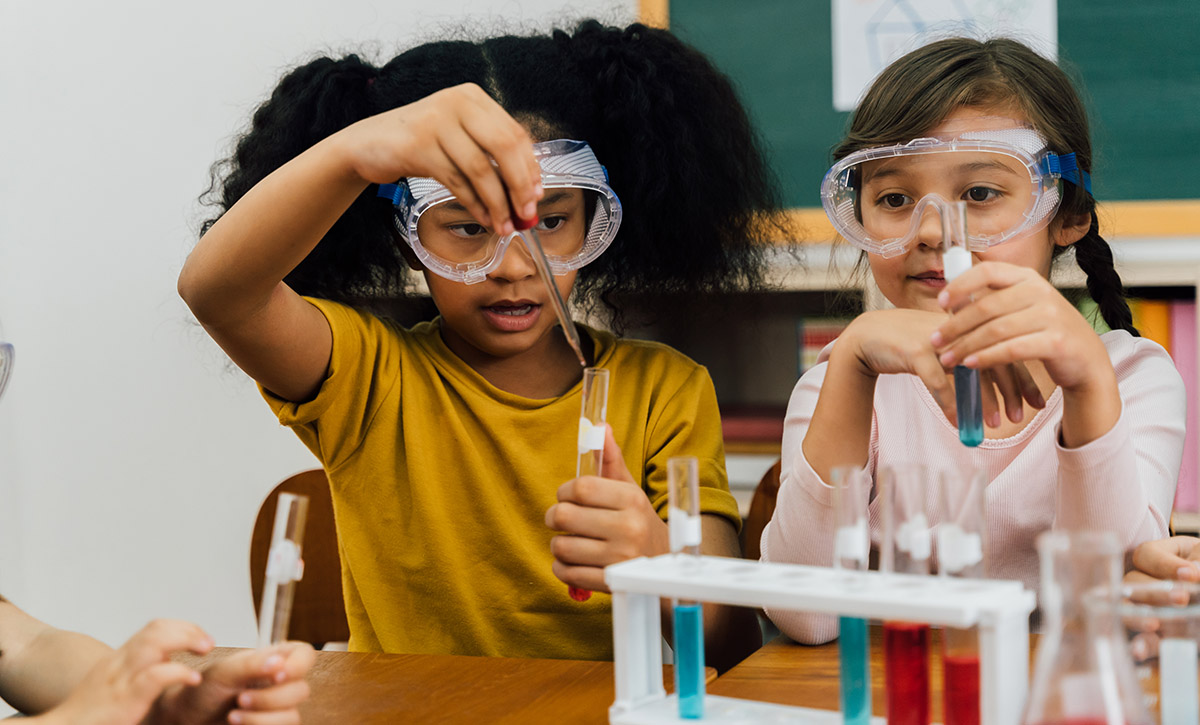Investing in Afterschool Programs Can Help Close Stubborn STEM Education Gaps
Hartung & Moritz: Out-of-school STEM programs are essential for setting up students for success — especially girls & other underrepresented groups

Get stories like this delivered straight to your inbox. Sign up for The 74 Newsletter
It’s no secret that STEM fields have an enormous representation problem. Women make up less than 30% of the nation’s workforce in science, technology, engineering and math, which rank among the fastest-growing and highest-paying career fields in today’s economy. For Black and Latino workers, the gap yawns even wider: They hold fewer than 10% of all STEM jobs.
STEM knowledge and skills are increasingly necessary to prepare students for the job market. Nearly a quarter of all occupations in the United States — in engineering, information technology, health care, construction and multiple other fields — require STEM competency. In the coming years, that share is predicted to grow.
Addressing underrepresentation and career preparation issues starts with the education system, but it is too much to ask schools to solve these problems by themselves. Some 80% of a child’s day is spent outside the classroom. That leaves plenty of time for other important and overlooked approaches — such as afterschool and out-of-school programs — that can offer additional time and more sustained opportunities to provide career exploration programming and augment the STEM teaching and learning that happens during the school day.
Afterschool and other out-of-school time settings can improve students’ grades, class behavior and homework completion. They also can provide opportunities for hands-on learning, play and other interesting activities that can spark a lifelong interest in STEM. Afterschool and out-of-school programs often have the flexibility to focus on students’ critical learning needs in ways schools cannot. They also can target and reach girls and other underrepresented populations with hands-on STEM learning opportunities that schools aren’t always equipped to offer. If students are set up for greater educational success earlier in their lives, the nation can construct stronger school-to-career pipelines that can produce more diverse and highly skilled talent.
Policymakers, including the new Congress, should continue to invest in programs that expand STEM education outside of school time to ensure that more young people have access to rigorous, relevant and joyful learning. For example, the Nita M. Lowery 21st Century Community Learning Centers program provides federal funding to community-based organizations, small businesses and other entities that offer high-quality afterschool and out-of-school experiences to more than 1.5 million youth annually. And it’s working: The Afterschool Alliance says the centers supported by this program have had positive impacts on student learning and growth and provided critical academic, emotional and social support to youth and their families during the pandemic.
The Education Innovation and Research grant program and the National Science Foundation’s STEM Education Directorate also are critical sources of funding. Congress should continue sufficient appropriations for these programs in particular, as well as to other initiatives that support afterschool STEM.
Additional executive actions can further support the growth of out-of-school STEM learning. The Biden administration has already invested billions of dollars in high-quality tutoring, summer learning and afterschool programs through the National Partnership for Student Success, Engage Every Student and YOU Belong in STEM. Billions of dollars in American Rescue Plan funding went to state education agencies and local school districts to beef up comprehensive afterschool, summer learning and extended school day and school year programming.
To continue this momentum, the U.S. Department of Education should establish a White House Initiative for STEM Educational Equity and Excellence to help states and local school districts use federal funds to develop engaging and high-quality STEM learning opportunities that can get students affected by the COVID-19 pandemic back on track. This initiative could more closely connect the department’s programs and policies to future workforce needs and help states and districts identify new grant programs and non-government partners to advance STEM learning.
Though recent federal actions demonstrate a clear commitment to leveraging the power of afterschool and out-of-school programs that focus on academic growth and well-being, these federally funded programs have so far lacked a specific focus on career exploration and workforce development. Going forward, federal and state policymakers must ensure their education initiatives include incentives for STEM learning and career preparation. Also, programs designed to develop and expand career pathways into STEM and other in-demand fields should include afterschool and out-of-school components so they can reach students outside the regular school day.
Successful approaches also require public and private partnerships with nonprofits, foundations and other organizations looking to show youth that STEM careers are within their reach. Jobs for the Future and STEM Next together are supporting Possible Futures, a free program designed to increase STEM opportunities for students in grades 6 to 10 by helping them explore STEM careers, gain valuable job skills and learn more about themselves and the modern world of work. Million Girls Moonshot is an afterschool campaign focused on equipping young women with the tools to become creative thinkers, problem solvers and innovators. Its youth ambassador program lets policymakers learn directly from participants and their families which approaches to STEM instruction work best. New federal investments might provide a historic opportunity to make more programs like these happen.
Because the lines between education and the workforce are blurred for students, and STEM skills are increasingly important for success in today’s fast-changing world of work, learning cannot stop at the end of the school day. Creating and investing in afterschool and out-of-school programs that promote STEM education is essential for setting up students for long-term success.
Disclosure: The Bill & Melinda Gates Foundation provides financial support to Jobs for the Future and The 74. The Carnegie Corporation of New York and the Charles and Lynn Schusterman Family Philanthropies provide financial support to the STEM Next Opportunity Fund and The 74.
Get stories like these delivered straight to your inbox. Sign up for The 74 Newsletter

;)

